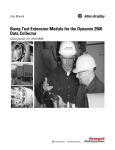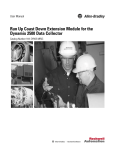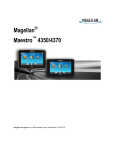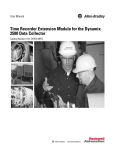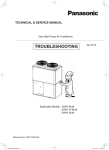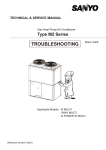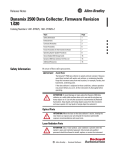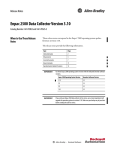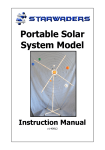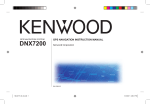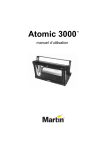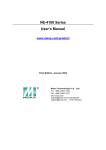Download 1441-UM004 - Rockwell Automation
Transcript
User Manual Balancing Extension Module for the Dynamix 2500 Data Collector Catalog Number 1441-DYN25-MBAL Important User Information Solid-state equipment has operational characteristics differing from those of electromechanical equipment. Safety Guidelines for the Application, Installation and Maintenance of Solid State Controls (publication SGI-1.1 available from your local Rockwell Automation sales office or online at http://www.rockwellautomation.com/literature/) describes some important differences between solid-state equipment and hard-wired electromechanical devices. Because of this difference, and also because of the wide variety of uses for solid-state equipment, all persons responsible for applying this equipment must satisfy themselves that each intended application of this equipment is acceptable. In no event will Rockwell Automation, Inc. be responsible or liable for indirect or consequential damages resulting from the use or application of this equipment. The examples and diagrams in this manual are included solely for illustrative purposes. Because of the many variables and requirements associated with any particular installation, Rockwell Automation, Inc. cannot assume responsibility or liability for actual use based on the examples and diagrams. No patent liability is assumed by Rockwell Automation, Inc. with respect to use of information, circuits, equipment, or software described in this manual. Reproduction of the contents of this manual, in whole or in part, without written permission of Rockwell Automation, Inc., is prohibited. Throughout this manual, when necessary, we use notes to make you aware of safety considerations. WARNING: Identifies information about practices or circumstances that can cause an explosion in a hazardous environment, which may lead to personal injury or death, property damage, or economic loss. ATTENTION: Identifies information about practices or circumstances that can lead to personal injury or death, property damage, or economic loss. Attentions help you identify a hazard, avoid a hazard, and recognize the consequence SHOCK HAZARD: Labels may be on or inside the equipment, for example, a drive or motor, to alert people that dangerous voltage may be present. BURN HAZARD: Labels may be on or inside the equipment, for example, a drive or motor, to alert people that surfaces may reach dangerous temperatures. IMPORTANT Identifies information that is critical for successful application and understanding of the product. Allen-Bradley, Rockwell Software, Rockwell Automation, Dynamix, Enpac, Emonitor, and TechConnect are trademarks of Rockwell Automation, Inc. Trademarks not belonging to Rockwell Automation are property of their respective companies. Table of Contents Preface Optional Extension Modules. . . . . . . . . . . . . . . . . . . . . . . . . . . . . . . . . . . . . . . . 5 Additional Resources . . . . . . . . . . . . . . . . . . . . . . . . . . . . . . . . . . . . . . . . . . . . . . . 6 Chapter 1 Installing Optional Extension Modules Install Extension Modules . . . . . . . . . . . . . . . . . . . . . . . . . . . . . . . . . . . . . . . . . . 7 Uninstall Extension Modules. . . . . . . . . . . . . . . . . . . . . . . . . . . . . . . . . . . . . . . . 9 Manage Extension Modules . . . . . . . . . . . . . . . . . . . . . . . . . . . . . . . . . . . . . . . 12 Extension Module Battery Status Indicators . . . . . . . . . . . . . . . . . . . . . . . . 13 Chapter 2 Balancing Extension Module Balancing Measurements. . . . . . . . . . . . . . . . . . . . . . . . . . . . . . . . . . . . . . . . . . Plane Balancing . . . . . . . . . . . . . . . . . . . . . . . . . . . . . . . . . . . . . . . . . . . . . . . . . . Static-couple Balancing . . . . . . . . . . . . . . . . . . . . . . . . . . . . . . . . . . . . . . . . . . . Set Up the Balancing Parameters . . . . . . . . . . . . . . . . . . . . . . . . . . . . . . . . . . Balance Setup Screen . . . . . . . . . . . . . . . . . . . . . . . . . . . . . . . . . . . . . . . . . Single Plane Balancing . . . . . . . . . . . . . . . . . . . . . . . . . . . . . . . . . . . . . . . . . . . . Single Plane Balancing Procedure Overview. . . . . . . . . . . . . . . . . . . . . Take the Initial Vibration Measurement. . . . . . . . . . . . . . . . . . . . . . . . Add the Trial Weight . . . . . . . . . . . . . . . . . . . . . . . . . . . . . . . . . . . . . . . . . Enter the Trial Weight Manually . . . . . . . . . . . . . . . . . . . . . . . . . . . . . . Estimate the Trial Weight. . . . . . . . . . . . . . . . . . . . . . . . . . . . . . . . . . . . . Take a Trial Run Weight Measurement . . . . . . . . . . . . . . . . . . . . . . . . Take a Correction Run . . . . . . . . . . . . . . . . . . . . . . . . . . . . . . . . . . . . . . . Perform a Trim Run . . . . . . . . . . . . . . . . . . . . . . . . . . . . . . . . . . . . . . . . . . Add the Correction Weight and Take a Residual Measurement . . Two Plane Balancing . . . . . . . . . . . . . . . . . . . . . . . . . . . . . . . . . . . . . . . . . . . . . Two Plane Balancing Procedure Overview . . . . . . . . . . . . . . . . . . . . . . How to Set Up a Two-Plane Procedure . . . . . . . . . . . . . . . . . . . . . . . . How to Perform Two-plane Balancing . . . . . . . . . . . . . . . . . . . . . . . . . Move Around in a Balance Run. . . . . . . . . . . . . . . . . . . . . . . . . . . . . . . . Saving, Loading, and Reviewing Balance Measurements . . . . . . . . . . . . . Save a Balance Measurement . . . . . . . . . . . . . . . . . . . . . . . . . . . . . . . . . . Load a Previously Saved Setup . . . . . . . . . . . . . . . . . . . . . . . . . . . . . . . . . Review Balancing Measurements. . . . . . . . . . . . . . . . . . . . . . . . . . . . . . . How to Delete Stored Files . . . . . . . . . . . . . . . . . . . . . . . . . . . . . . . . . . . . 16 16 18 20 21 26 26 27 28 29 30 32 35 37 41 45 46 46 50 60 61 61 62 63 64 Index Rockwell Automation Publication 1441-UM004A-EN-P - May 2011 3 Table of Contents Notes: 4 Rockwell Automation Publication 1441-UM004A-EN-P - May 2011 Preface This manual describes the Balancing extension module for the Dynamix 2500 data collector. You install the extension module with the Balancing Secure Digital (SD) card. See Installing Optional Extension Modules on page 7 for installation instructions. The balancing test determines the amount and location of the heavy spot on a rotating shaft so that you can balance it with an equal amount of weight in the opposite direction. There are three types of measurements in the balancing process: • Initial Vibration • Trial Weight • Residual Measurements Optional Extension Modules These are the optional extension modules for the Dynamix 2500 data collector: • 1441-DYN25-4C, 4-channel Activation (1) The 4-channel activation lets you take 3- and 4-channel magnitude, time waveform, spectra, and Offroute measurements. • 1441-DYN25-MBMP Bump Test A bump test (or hammer test) determines the natural frequencies of a machine or a structure. • 1441-DYN25-MBAL Balancing Balancing application resolves single-plane, two-plane, and static-couple balances with high precision. • 1441-DYN25-MFRF Frequency Response Function The FRF test lets you determine the natural frequencies of a machine as well as sophisticated information about the frequency response of the structure being tested. • 1441-DYN25-MREC Time Recorder The Time Recorder test uses a the instrument as a data recorder for realtime data acquisition and analysis. • 1441-DYN25-MRUC Run Up Coast Down The RUCD test records and analyzes data from intermittent events and transient vibration signals from non-steady state machines. See Additional Resources on page 6 for a listing of available publications. (1) This is an activation license for the Dynamix 2500 data collector. Rockwell Automation Publication 1441-UM004A-EN-P - May 2011 5 Preface Additional Resources These documents contain additional information concerning related products from Rockwell Automation. Resource Description Dynamix 2500 Data Collector User Manual, publication 1441-UM001 Describes the Dynamix 2500 data collector which provides predictive maintenance by using noise and vibration analysis. Bump Test Extension Module for the Dynamix 2500 Data Collector User Manual, publication 1441-UM002 Describes how determine natural (or resonant) frequencies of a machine or structure. Frequency Response Function Extension Module for the Dynamix 2500 Data Collector User Manual, publication 1441-UM003 Describes how to determine the natural frequencies of a machine or structure by using modal hammer. Time Recorder Extension Module for the Dynamix 2500 Data Collector User Manual, publication 1441-UM005 Describes how to use the data collector as a data recorder for real-time data acquisition, post processing, and analysis. Run Up Coast Down Extension Module for the Dynamix 2500 Data Collector User Manual, publication 1441-UM006 Describes how to record and analyze data from intermittent events and transient vibration signals from non-steady state machines. Emonitor User’s Guide, publication EMONTR-UM001 Describes data management for predictive maintenance services. Dynamix 2500 Data Collector Kit Release Notes, publication 1441-RN001 Provides information on the latest updates, for example, firmware, certifications, warnings, and hardware changes for the data collector. Dynamix 2500 Data Collector Optional Extension Modules Release Notes, publication 1441-RN002 Provides information on how to install the Optional Extension Modules on to the Dynamix 2500 data collector. Industrial Automation Wiring and Grounding Guidelines, publication 1770-4.1 Provides general guidelines for installing a Rockwell Automation industrial system. Product Certifications website, http://www.ab.com Provides declarations of conformity, certificates, and other certification details. You can view or download publications at http://www.rockwellautomation.com/literature. To order paper copies of technical documentation, contact your local Allen-Bradley distributor or Rockwell Automation sales representative. 6 Rockwell Automation Publication 1441-UM004A-EN-P - May 2011 Chapter 1 Installing Optional Extension Modules The data collector uses the Extension Manager to install and uninstall extension modules. These extension modules are licensed and ordered separately from the basic entry-level product. Install Extension Modules Topic Page Install Extension Modules 7 Uninstall Extension Modules 9 Manage Extension Modules 12 Extension Module Battery Status Indicators 13 The installation Secure Digital (SD) cards that you receive work with any Dynamix 2500 data collector. Once you have installed an extension module, the card is locked so that it can only be used with that instrument. IMPORTANT One installation SD card is required for each instrument that needs to be upgraded. You can uninstall extension modules if required. When uninstalling an extension module, you have the option to free up the license so you can install the extension module on another instrument. This makes the extension module available to be transferred between units. IMPORTANT When ever you re-run the OS Loader software, you will re-load only the main OS firmware. The OS loader will backup licence files and data, but not the optional extension modules. Once you have updated the OS firmware, insatll the latest version of your optional extension modules. See the Dynamix 2500 Data Collector User Manual, 1441-UM001, for more information. Follow these instructions to install an extension module. 1. Open the base cover at the bottom of the Dynamix 2500 data collector. 2. Place the extension module SD card contact side-up into the unit until it is firmly seated in place. 3. Close the base cover. Rockwell Automation Publication 1441-UM004A-EN-P - May 2011 7 Chapter 3 Installing Optional Extension Modules 4. Apply power to the data collector. 5. From the Main Menu, select Setup Utility and press Enter. 6. Press 0 (Shift) to display the second set of functions. Extension Manager The Extension Manager function remains on the screen for about three seconds after releasing 0 (Shift). 7. Press F1 (Extn Mgr). The Extension Manager screen appears showing the current extension module installations. 8. Press 0 (Shift) to display the Install Extension function. 9. Press F2 (Install) to install the new extension module. 8 Rockwell Automation Publication 1441-UM004A-EN-P - May 2011 Installing Optional Extension Modules Chapter 3 When the installation is complete, a confirmation prompt appears. 10. Press F4 (OK). The new extension module appears in the list. 11. Press F4 (Esc) to exit the Extension Manager screen. Uninstall Extension Modules Follow these instructions to uninstall an extension module. 1. Press 0 (Shift) from the Setup Utility screen to display the Extension Manager function. The Extension Manager function remains on the screen for about three seconds after releasing 0 (Shift). Extension Manager 2. Press F1 (Extn Mgr). Rockwell Automation Publication 1441-UM004A-EN-P - May 2011 9 Chapter 3 Installing Optional Extension Modules The Extension Manager screen appears. This screen lists the extension modules currently installed and the on the unit. 3. Select the extension module you want to uninstall and press F3 (Select). F3 (Select) toggles the selection on and off. A checkmark appears next to that extension module. 4. Press F1 (Uninstall). 10 Rockwell Automation Publication 1441-UM004A-EN-P - May 2011 Installing Optional Extension Modules Chapter 3 A confirmation message appears. 5. Make sure your installation card is inserted into the instrument. IMPORTANT The extension module is uninstalled and the license on the card is released so that the card can be used to install the extension module on another Dynamix 2500 data collector. If the installation card is not inserted in the instrument and no card, you are is found or the card does not have the extension module license for the unit, you are prompted to insert the correct installation card or continue without freeing the license. 6. Press F2 (Yes) to uninstall the extension module. 7. Press F4 (Esc) to exit the Extension Manager screen. Rockwell Automation Publication 1441-UM004A-EN-P - May 2011 11 Chapter 3 Installing Optional Extension Modules Manage Extension Modules The Dynamix 2500 data collector lets you to hide installed extension modules from the Main Menu. You may need to hide an advanced extension module icon from an inexperienced user, for example, RUCD and FRF. IMPORTANT Once an extension module is hidden, its icon is not represented on the Main Menu or displayed in the Dynamix 2500 data collector About screen. Follow these instructions to hide or show an extension module icon on the Main Menu. 1. Press 0 (Shift) on the Setup Utility screen to display the Extension Manager function. The Extension Manager function should remain on the screen for approximately three seconds after releasing 0 (Shift). 2. Press F1 (Extn Mgr). The Extension Manager screen appears. The Extension Manager displays a list of installed extensions module. The extension modules that are hidden are shown in [square brackets]. The F2 (Hide) toggles between Hide and Show depending if the selected extension module is hidden or not. TIP 12 You have to exit and re-enter the Extension Manager after hiding an extension module to have the Show function appear. Rockwell Automation Publication 1441-UM004A-EN-P - May 2011 Installing Optional Extension Modules Chapter 3 3. Select the extension module that you want to hide or show and press F2 (Show/Hide). TIP If you want to show or hide multiple extension modules simultaneously, select each extension module and press F3 (Select). A checkbox appears next to each selected extension module. If you select multiple extension modules and some are hidden while others are shown, F2 (Show/Hide) reflects the status of the selected extension module. 4. Press F4 (Esc) to exit the Extension Manager. Extension Module Battery Status Indicators The battery status icons show the strength of the battery. Table 1 - Extension Module Battery Icon Descriptions Battery Icon Meaning Battery status is good: >30% life remaining. Battery status is low: >10% life remaining. Battery status is very low: <10% life remaining. Battery is charging. Rockwell Automation Publication 1441-UM004A-EN-P - May 2011 13 Chapter 3 Installing Optional Extension Modules Notes: 14 Rockwell Automation Publication 1441-UM004A-EN-P - May 2011 Chapter 2 Balancing Extension Module The Balancing extension module is an optional module for the Dynamix 2500 data collector. You install the extension module with the Balancing Secure Digital (SD) storage card. Topic Page Balancing Measurements 16 Plane Balancing 16 Static-couple Balancing 18 Set Up the Balancing Parameters 20 Single Plane Balancing 26 Two Plane Balancing 45 Saving, Loading, and Reviewing Balance Measurements 61 Balancing application resolves single-plane, two-plane, and static-couple balances with high precision. You can use the Dynamix 2500 data collector coupled with a speed-measuring device such as a strobe light or laser tachometer. The Dynamix 2500 data collector Balancing extension module provides a simple, direct method to balance your rotating machinery in one or two planes. You can use the internal laser tachometer in the data collector or an external laser tachometer, optical tachometer, or strobescope for measuring phase during the balance run. Rockwell Automation Publication 1441-UM004A-EN-P - May 2011 15 Chapter 2 Balancing Extension Module Balancing Measurements Balancing is the technique for determining the amount and location of the heavy spot on a rotating shaft so that you can balance it with an equal amount of weight in the opposite direction. These methods go through the technique with stopping points where you start and stop the machine to perform weight addition or subtraction. There are three types of measurements in the balancing process: • Initial Vibration The initial vibration measurement is taken without any added weights on the machine. The initial vibration measurement establishes a reference of how the machine vibrates at each plane without any extra weight added. This vibration is what will be corrected by the correction weight. • Trial Weight The trial weight measurements are taken with a single trial weight attached to the machine at one plane or the other. The trial weight measurements are used to determine how the machine is affected by the added weight. The ideal trial weight should produce either a 30 % change in amplitude or a 30° change in phase. • Residual Measurements The residual measurements are taken with the correction weight or the correction weight and trim weights attached to the machine. The correction weight should cancel out the initial unbalance. A residual vibration measurement is taken to measure the remaining unbalance. Trim weights are added to the machine to cancel out the vibration measured during a residual measurement. Plane Balancing Regardless of whether you are performing a single or two-plane balancing procedure, all balancing procedures progress through basic runs as you start (spin) and stop the rotor. For two-plane procedures, you perform some of the runs twice, once with weights on correction plane one and again with weights on correction plane two. For simplicity, the following example describes a single-plane procedure. These are the steps you need to take to take a single-plane balancing measurement. 1. Set up balancing equipment and the Balancing parameters. With the machine stopped, set up the balancing equipment and mark your tachometer reference point on the rotor or shaft. See Set Up the Balancing Parameters on page 20 to configure balancing measurement parameters for the balancing run sequence. 16 Rockwell Automation Publication 1441-UM004A-EN-P - May 2011 Balancing Extension Module Chapter 2 2. Perform the initial measurement. a. Start the machine. b. Take the initial measurement. The initial measurement provides a starting place for balancing computations. It records the machine's initial imbalance, 1X vibration magnitude and phase angle. Later in the procedure, initial measurement data is automatically compared with trial (weight) measurement data to calibrate the machine's imbalance. 3. Attach a trial weight. a. Stop the machine after collecting the initial measurement data. b. Add a trial weight. A trial weight is a temporary weight attached to produce a change from the original unbalance readings (reference run readings). Input the trial weight amount and placement angle into the data collector. 4. Perform the trial measurement. a. Start the machine again with the trial weight securely attached. b. Take trial measurement with the trial weight. The trial measurement calibrates the machine's unbalance and allows the data collector to calculate the influence coefficient and permanent correction weight amount and placement. To allow for accurate balancing computations, the trial weight should pass the 30/30 rule. The trial weight should do the following: • Increase or decrease the 1X vibration amplitude by at least 30 % • Change the phase angle by at least 30° • Be a combination of A and B. 5. Attach the correction weight. a. Stop the machine. b. Remove the trial weight c. Attach the specified correction weight at the specified angle. 6. Perform a correction weight measurement. a. Start the machine again. b. Take correction weight measurement. The correction weight run performs two functions: • It calculates the amount of residual imbalance with the correction weight in place to confirm that the machine is now balanced within tolerances. • If further balancing is necessary, it automatically applies the influence coefficient to calculate additional trim weights that can be added to further balance the machine. Rockwell Automation Publication 1441-UM004A-EN-P - May 2011 17 Chapter 2 Balancing Extension Module 7. If additional trim weights are necessary to balance the machine within tolerances, stop the machine and attach the specified trim weights. a. Stop the machine. b. Attach the specified trim weights. c. Take another measurement. 8. Perform a trim measurement. a. Start the machine. b. Take a trim measurement to verify the machine is balanced within tolerances. If not, you can take additional trim measurements. Static-couple Balancing With stiffer rotors, a two-plane procedure may reduce the amount of imbalance to target tolerances. However, with narrow or flexible rotors, more often a static-couple procedure works best. This graphic shows a narrow rotor showing three heavy spots. The static-couple procedure corrects the static unbalance with weights added to the center of gravity plane, and corrects the couple unbalance with weights added to the end planes. In practice, a static-couple balancing procedure is almost identical to a two-plane balancing procedure, except that it provides three correction weight solutions instead of two. One correction weight for each plane, and an additional correction weight to correct the static unbalance. Unless you are able to attach weights to the machine’s center of gravity plane, the static weight is typically split in half and applied to the end planes to correct the static unbalance. In as such, on the data collector, the static-couple procedure is identical to the two-plane procedure except the Correction Weight and Trim Weight screens show three correction weights for the static-couple procedure: • One weight for end plane 1 • One weight for end plane 2 18 Rockwell Automation Publication 1441-UM004A-EN-P - May 2011 Balancing Extension Module Chapter 2 Except for the Solution field, all static-couple balancing parameters are identical to two plane balancing settings. If you want to compute three correction weights, select Static-Couple for the Solution parameter on the Balance - Setup screen. See Balance Extension Module Parameters on page 22 for more information about these parameters. Except for attaching three correction and trim weights instead of two (or four if you split the static weight), all static-couple balancing run procedures are identical to the two-plane balancing procedures. See Two Plane Balancing on page 45 on how to perform a two- plane Procedure section for details. Rockwell Automation Publication 1441-UM004A-EN-P - May 2011 19 Chapter 2 Balancing Extension Module Set Up the Balancing Parameters All balancing measurement parameters are set up from Balance Setup screen. Follow these steps to go to the Balancing extension module. 1. From the Main Menu, select Balancing and press Enter. The Balance menu displays. These are the Balance menu options: • Setup Access the Balance - Setup screen where you can set up and perform a new balancing run. • Recall Access the Balance - Load Setup screen where you can select a previously saved balancing run and perform a new run by using the saved settings. • Review Review Data screen where you can review previously stored measurements or resume a previous balance measurement from the last completed run. 20 Rockwell Automation Publication 1441-UM004A-EN-P - May 2011 Balancing Extension Module Chapter 2 Balance Setup Screen After setting up your balance measuring equipment and marking your tachometer reference point, the next step is to configure balancing measurement parameters for the balancing run sequence. Follow these steps to setup the Balancing parameters. 1. From the Balance main menu, select Setup and press Enter. The Balance Setup lets you configure the balance measurement parameters. 2. Select an option and press the Right arrow to open a list choices. 3. Use the arrow keys to select a parameter. 4. Press the Left arrow to save your selection. Use the descriptions in Balance Extension Module Parameters to help you configure the parameters in the Balance Setup screen. 5. Save the setup or start taking the balancing measurement. Rockwell Automation Publication 1441-UM004A-EN-P - May 2011 21 Chapter 2 Balancing Extension Module Table 2 - Balance Extension Module Parameters Parameter Description Value Num. of Planes Determines whether single-plane or two-plane balancing is required. A good rule-of-thumb is the rotor’s width-to-diameter (W/D) ratio. The W/D ratio is the width (excluding shaft length) of the combine rotors divided by their diameter. The following chart can be used to help determine whether to use one- or two-plane balancing. 1 2 (default) W/D RATIO 1-PLANE 2-PLANE Less than 0.5 0 - 1000 RPM Above 1000 RPM More than 0.5 but less than 2 0 - 150 RPM 150 - 2000 RPM or above 70% of 1st critical 0 - 100 RPM Above 100 RPM to 70% of 1st critical width diameter width diameter width diameter More than 2 Num. Transducer Determines the number of transducers to be used. Connector A and B Sensor (transducer) Type Vibration measurement type. Accel (G) (default) The type of vibration measurement depends on the type of transducer used, for example, accelerometer, velocity pickup, or proximity probe. This is required to establish integration requirements for the FFT calculation. Vel IPS Typically, accelerometers are used to perform velocity measurements for field balancing procedures. Disp mil A Manual Entry option is available at the end of the list for manual balancing data entry, letting you to review and change balancing run data. If selected, you are prompted to manually enter the running speed, vibration magnitude, and phase angle for the balancing runs. Vel mm/s Disp um Manual Entry Display Units Specify the unit of measurement for the select transducer type. The options available in the list vary depending on the transducer selected. EU Weight Units Defines the units used in balancing. g Specify the units of measurement used for your trial, correction, and trim weights. kg oz (default) lb EU 22 Rockwell Automation Publication 1441-UM004A-EN-P - May 2011 Balancing Extension Module Chapter 2 Table 2 - Balance Extension Module Parameters Parameter Description Value Length Units Specifies the units of measurement used for measuring the radius of the weight placement (from the shaft center to the position of the weight). mm You can use this information when you have the data collector to estimate the trial weight for you. m cm inch (default) feet EU Movement Specify your weight angle placement convention, either With Rotation or Against Rotation. During a balancing procedure, when weight angle placements are specified, this setting determines their direction from the zero reference point. With Rotn Against Rotn (default) You place weights on the rotor to balance the machine. The position of this weight is given in degrees or positions (where the total number of positions equals the number of blades or vanes) from the reference notch or mark. You must select whether you are measuring the angle with or against the direction of the shaft rotation. The Movement parameter affects how the angles are measured. If Movement is set to "With Rotn," angles are measured from the reference mark, in the direction of the machine’s normal rotation. If Movement is set to "Against Rotn," angles are measured from the reference mark, in the opposite direction of the machine’s normal rotation. Trigger Type Sets the trigger source: • External Analog - An external trigger will be used to trigger data sampling. You must also set the slope and trigger level. • Laser Tach - Enables the internal Laser Tachometer new firmware and ext modules coming soon check SKF to confirm this function. should be fixed Ext trig slope Ext Analog (default) Laser Tach Sets the slope for externally triggering the measurement. -ve Slope is the direction in which the signal is moving, and is either positive (rising) or negative (falling) before a trigger is detected. +ve (default) This parameter is applicable only when Trigger Type is set to ext Analog or ext TTL. Trigger Level Amplitude level for the external trigger the measurement. volts Enter the number of volts to eliminate noise, which may cause false triggering. 2 V (default) This is applicable only for external analog trigger type measurements. Vib. Threshold The acceptable imbalance level you are trying to achieve. If the vibration magnitude is greater than this threshold, the magnitude bar is colored red when taking a reading. The bar turns green when the selected level of imbalance is achieved. 1.00 EU (default) Filter Sets the high pass filter to. apply to the measurement. Off The high pass filter is useful in removing high vibration, low frequency signal components, which can dominate the signal. 2 Hz (default) Rockwell Automation Publication 1441-UM004A-EN-P - May 2011 10 Hz 23 Chapter 2 Balancing Extension Module Table 2 - Balance Extension Module Parameters Parameter Description Value Detection Selects the type of signal detection and scaling for the measurement: Peak: Scaled from RMS as 2 RMS • Peak - The data collector measures the dynamic signal from zero to peak voltage. Use this or the RMS setting for most acceleration and velocity measurements. • Pk-Pk - The data collector measures the dynamic signal from the minimum peak to the maximum peak. Use this setting for most displacement measurements. • RMS - The data collector measures the dynamic signal as the square root of the mean of the square. Use this or Peak for most acceleration and velocity measurements. Also use this for voltage measurements. Pk-Pk: Scaled from RMS as 2 2 RMS RMS: The Root Mean Squared overall calculated from the FFT or time data. Defaults to Peak for Accel Defaults to Vel and Pk-Pk for Disp. No. Averages Enter the number of averages (1 to 8) for the measurement. 4 (default) Solution Select the balancing solution. The parameter is available only when you are two-plane balancing: Dynamic (default) • Dynamic - The correction weights will be calculated for both planes 1 and 2. • Static-Couple - The correction weights will be calculated as a combination of Static and Couple. The Couple balance weights will be presented as the same weight in both planes 1 and 2, with a phase angle of 180° difference. The Static part of the solution will be calculated at the center between planes 1 and 2. 24 Rockwell Automation Publication 1441-UM004A-EN-P - May 2011 Static-Couple Balancing Extension Module Chapter 2 Table 2 - Balance Extension Module Parameters Parameter Description Value Plane (x) Sets the plane for which the settings below apply. 1 Two plane get two sets of the following attributes/parameters (settings) The input channel required for the measurement. 2 X (default) on connector A only Select channel X for single-plane balancing, with the transducer connected to the data collector’s Connection A. Y, on Connector B Input Chan For two-plane balancing with two transducers, you set one plane’s transducer as channel X, the other plane’s transducer as channel Y. See Two Plane Balancing on page 45 for more information. Coupling The type of coupling to be applied to the measurement. • AC, Acquires the input signal from a buffered output (external) device. Power is not applied to the transducer. • ICP, Applies DC to the charge amplified transducer signal and couples the dynamic signal to the input channel. Sensitivity The sensitivity of the transducer. Sensitivity is set as mV/EU, where EU is the base engineering unit of the transducer. Use the keypad to enter the transducer sensitivity in millivolts (mv) per Engineering Unit (EU). 100 mV/EU is used for most acceleration transducers, 200 mV/EU for most non-contact displacement transducers, and 1000 mV/EU if the input is volts and the scales is to be read directly. The default setting is 100 mV/EU. Input Range Select the signal input range between Autorange and a fixed range in transducer units in a 1 - 2 - 5 sequence. The available fixed values vary depending on the transducer type being used. AC ICP (default) 0.010 to 1000 mV/EU A 100 m V/G accelerometer would be set as 100 m V/EU Autoranging If a fixed range is selected and the data collector detects an over range, it automatically selects the next higher range until it does not over range. Type Select the appropriate weight position type, Continuous (default) For a rotor without vanes or blades, set Type to Continuous. Fixed Continuous specifies that weights may be placed at any placement position on the balance plane. Fixed is known also as vector splitting. It works with Number of Positions and Position 1 Offset fields. Fixed specifies that weights may be placed only at designated positions, for example, rotors having a specific weight hole pattern, or with a specific number of fan blades. No. of posns Posn 1 Offset Applies to Fixed weight position measurements only. 3 to 360° The first position defaults to 0°, subsequent positions evenly spaced.The number of positions refers to the number of rotor components, such as blades on a fan. Enter 0 (zero) for a rotor without vanes or blades. Applies to Fixed weight position measurements only. 0 to 360° Enter the fixed position 1 offset, from zero to 360°, relative to the trigger reference. Rockwell Automation Publication 1441-UM004A-EN-P - May 2011 25 Chapter 2 Balancing Extension Module Single Plane Balancing The balancing of a machine in one plane is divided into taking these three measurements: • Initial measurement • Trial weight measurement • Residual measurement You must complete the entire procedure until the vibration level has been reduced enough for your needs. See Balancing Measurements on page 16 for more information. Single Plane Balancing Procedure Overview This is an overview of the steps you need to take when performing a single plane balancing measurement. 1. Take the Initial Vibration Measurement on page 27. 2. Add the Trial Weight on page 28. a. Enter the Trial Weight Manually on page 29. b. Estimate the Trial Weight on page 30. 3. Take a Trial Run Weight Measurement on page 32. 4. Take a Correction Run on page 35. 5. Perform a Trim Run on page 37. 6. Combine the Balance Run Weights on page 38. 7. Add the Correction Weight and Take a Residual Measurement on page 41. a. Split the Correction Weight on page 42. b. Modify the Radius on page 42. c. Add or Remove Weight on page 42. d. Take the Residual Measurement on page 42. 26 Rockwell Automation Publication 1441-UM004A-EN-P - May 2011 Balancing Extension Module Chapter 2 Take the Initial Vibration Measurement The initial vibration measurement is taken without any added weights on the machine. The initial vibration measurement establishes a reference of how the machine vibrates at each plane without any extra weight added. This vibration is what will be corrected by the correction weight. TIP Skip step 1 if you are using the internal Laser Tachometer as the trigger source. 1. If you are using an external tachometer, optical tachometer, or strobescope as the trigger source, then connect the tachometer cable to the POWER/ USB/TRIGGER connector at the top of the data collector. 2. Attach a transducer to the machine to be balanced. 3. Mark the rotor by making a mark on one rotor that will serve as a reference mark. It is also possible to use an existing mark on the rotor as the reference mark, such as a key or keyway. IMPORTANT If the rotor has multiple positions (vanes or fan blades), the reference mark must be at one of the blade positions. 4. Start the machine and allow it to reach normal running speed. 5. Press Enter to take the initial vibration measurement. TIP Depending on your setup, the Dynamix 2500 data collector may ask if the transducer is attached to plane 1. If the transducer is attached, press F4 (OK). Rockwell Automation Publication 1441-UM004A-EN-P - May 2011 27 Chapter 2 Balancing Extension Module The data collection begins as soon as the trigger conditions are satisfied. The Dynamix 2500 data collector automatically measures the speed, vibration, and plane. The values are continually updated on the screen. Running Speed Vibration Magnitude and Phase Phase Angle and Magnitude Diagram IMPORTANT Note the speed reading at the top of the display. For accurate balancing results, it is important to maintain the same speed across all balancing runs. It is recommended that you save the initial run so that you do not have to repeat it. Then you can update the saved file with subsequent runs. 6. When the speed, vibration, and phase values are stable, press Enter to complete the initial vibration measurement. The results are stored in the Vibration Summary Table. 7. Shut down the machine and continue the balancing procedure. TIP Anytime during the initial run, you can do the following: • Press F4 (Esc) to exit the balancing module. • Press the 0 (Shift) key and F1 (Go to) to simultaneously go back to a previous step in the balance run. See Move Around in a Balance Run on page 60 for details. • Press F2 (Summary) to display the results in the Vibration Summary Table. Add the Trial Weight The Add Trial Weight screen appears when the initial run measurement is complete. You can manually enter the trial weight, the angle, and the radius, or you can have the data collector automatically estimate the trial weight for you. 28 Rockwell Automation Publication 1441-UM004A-EN-P - May 2011 Balancing Extension Module Chapter 2 Enter the Trial Weight Manually Follow these instructions to manually enter the trial weight you are attaching to the machine. A negative number can be entered if trial weight is removed, instead of added. Trial weights are typically attached at 0° (the trigger reference). Unless you wish the data collector to estimate a trial weight, the Radius entry is not necessary, so long as you position the trial, correction, and trim weights at the same radius. 1. On the machine, carefully attach the precise weight at the precise angle and radius specified. Balancing results depend greatly on the precision of your measurements and actions. 2. Use the Up/Down arrows to select the parameters and the Right arrow to enter trial weight, angle, or radius value by using the numeric key pad. In the Mass parameter, enter the trial weight. Enter rotor mass supported in this plane (in the Weight Units specified on the Balance Setup screen). Use total rotor mass for single plane and 50% of mass for two plane. 3. In the Angle parameter, enter the location (in degrees) of the trial weight on the rotor. The trial weight’s Angle placement is typically zero. The angle is measured from the reference mark in the direction specified in the Movement parameter in the Balance Setup screen. See Set Up the Balancing Parameters on page 20 for additional information. 4. In the Radius parameter, enter the radius of the trial weight. 5. Press OK. Rockwell Automation Publication 1441-UM004A-EN-P - May 2011 29 Chapter 2 Balancing Extension Module You are returned to the Add Trial Weight screen where the estimated trial weight displays in both the Mass and Estimated Mass fields. Estimate the Trial Weight At times, you may want the data collector to calculate the trial weight for you. The Trial Weight Estimate is based on the criteria that the trial run centrifugal force does not exceed 10% of the bearing shaft load. The Dynamix 2500 data collector calculates the trial weight (mass), the angle, and the radius by using the following formula. .1 rotor mass 9.81 900Trial Weight = ------------------------------------------------------------------radius [speed 2 Follow these instructions to estimate the trial weight. 1. From the Add Trial Weight screen, enter the trial weight’s Angle placement (typically zero) and Radius. 2. Press F3 (Estimate). You are prompted to enter the rotor’s mass support in this plane. 3. Enter rotor mass supported in this plane (in the Weight Units specified on the Balance Setup screen). Use total rotor mass for single plane and 50% of mass for two plane. 4. Press F2 (OK). You are returned to the Add Trial Weight screen where the estimated trial weight displays in both the Mass and Estimated Mass fields. 30 Rockwell Automation Publication 1441-UM004A-EN-P - May 2011 Balancing Extension Module Chapter 2 5. When the speed, vibration, and phase values are stable, press Enter. The trial weight measurement is complete and the results are stored in the Vibration Summary Table. A message appears asking if the trial weight is still attached: • Press F2 (Yes) if the weight is still attached to the rotor. • Press F3 (No) if the weight has been removed from the rotor. TIP It is good practice to remove the trial weight. 6. Shut down the machine. TIP Anytime during the initial run, you can do the following: • Press F4 (Esc) to exit the balancing program. • Press 0 (Shift) and F1 (Go to) simultaneously to go back to a previous step in the balance run. See Move Around in a Balance Run on page 60 for details. • Press F2 (Summary) to display the results in the Vibration Summary Table. See Review Balancing Measurements on page 63 for details. Rockwell Automation Publication 1441-UM004A-EN-P - May 2011 31 Chapter 2 Balancing Extension Module Take a Trial Run Weight Measurement The trial weight measurements are taken with a single trial weight attached to the machine at one plane or the other. The trial weight measurements are used to determine how the machine is affected by the added weight. The ideal trial weight should produce either a 30 % change in amplitude or a 30 ° change in phase. Follow these instruction to take a trial weight measurement. 1. With the trial weight securely attached to the machine, start the machine and bring it back up to the same speed used with the initial run. 2. Press Enter to start taking trial weight measuremnt. The Trial Run 1 screen shows vibration magnitude and phase readings with the trial weight attached. For accurate balancing efforts, these readings should satisfy the 30/30 rule. From the reference run, the trial weight causes a 30% change in magnitude, or a 30 degree change in phase, or both. The Dynamix 2500 data collector automatically analyzes the data to determine if the 30/30 rule is being met. • The Trial Run magnitude is between 70% and 130% of the Initial Run magnitude, and the Trial Run phase is within ±30 of the Initial Run phase, the 30/30 rule is not being met, this warning appears: 32 Rockwell Automation Publication 1441-UM004A-EN-P - May 2011 Balancing Extension Module Chapter 2 • If the Trial Run magnitude is over 200% of the Initial Run magnitude, this warning appears: 3. In either case, press F2 (Yes) to return to the Add Trial Weight – Plane 1 screen where you can adjust your settings or press F3 (No) to continue with the current settings. With the 30/30 rule satisfied, the data collector uses differences between the reference run readings and trial run readings to compute the influence coefficient, which it uses to compute the permanent correction weight solution. 4. If you need to, correct any values. 5. From the Trial Weight Measurement screen, press Enter to proceed. Before computing the correction weight solution, you are prompted to indicate whether the trial weight is to remain attached or be removed. Trial weights are normally temporary, and removed before one final correction weight is attached. However, sometimes the trial weight must be permanently attached for safety purposes, and is therefore left on the machine. 6. Select No, as you typically plan to remove the temporary trial weight (or select Yes if you plan to leave the trial weight attached). Rockwell Automation Publication 1441-UM004A-EN-P - May 2011 33 Chapter 2 Balancing Extension Module The Correction Weight – Solution screen displays. 7. From the Correction Weight Solution screen, press Enter to begin the correction run. The Correction Weight – Solution screen displays fields at the top of the screen, and the permanent correction weight mass, angle, and radius balance solution for the field settings. Parameter Description Split Mass? Sometimes a weight cannot be placed at the angle specified by balancing computations. The Split Mass? option automatically splits the specified weight into two weights positioned at two placement angles around the original angle. Weight Add/Subtract Specifies whether you are adding or subtracting the correction weight. Mass and Angle settings automatically adjust per your selection. Defaults to Add. Radius Lets you to specify a new weight placement radius. Mass and Angle settings automatically adjust for the new radius. If you split weights, a radius setting is available for each weight. Angle (1) / Angle (2) Applicable only if you split weights. Lets you to specify the placement angle for the two weights. Both angles must be specified for weight recalculation. The data collector recalculates the weight for each position based on the relative phase between the correction weight and the split weight locations. 8. Stop the machine, remove the temporary trial weight, and securely attach the permanent correction weight at the precise angle and radius specified. 34 Rockwell Automation Publication 1441-UM004A-EN-P - May 2011 Balancing Extension Module Chapter 2 Take a Correction Run The Correction Run screen displays, showing the amount of residual unbalance with the correction weight attached. If the vibration magnitude is greater than this threshold, the magnitude bar is colored red when taking a reading. The bar turns green when the selected level of imbalance is achieved. Verify whether the amount of residual unbalance is within specifications for the machine. If the amount of residual imbalance is within specifications, you can end the balance measurement, if not, you should proceed with a trim run. 1. Press Enter. You are prompted whether you wish to perform7 a trim run. The data collector automatically measures the speed, vibration, and phase. The values are constantly updated on the screen. 2. If necessary, press Yes to proceed with a trim run. Rockwell Automation Publication 1441-UM004A-EN-P - May 2011 35 Chapter 2 Balancing Extension Module The Trim 1 Weight - Solution screen displays the trim weight data (or press No to end the balance measurement). 3. If Necessary, attach a Trim Weight. The Trim 1 Weight – Solution screen displays the trim weight mass, angle, and radius to help balance the residual. 4. Stop the machine and securely attach the permanent trim weight at the precise angle and radius specified. 36 Rockwell Automation Publication 1441-UM004A-EN-P - May 2011 Balancing Extension Module Chapter 2 Perform a Trim Run You can repeat trim runs until you are satisfied that you have the finished the balancing measurement. Follow these instructions to perform a Trim Run. 1. With the trim weight securely attached, start the machine and press an Enter button to perform the trim run. The Trim Run 1 screen displays the amount of residual unbalance with the trim weight attached. 2. Verify whether the amount of residual unbalance is within specifications for the machine. If the amount of residual unbalance is within specifications, you can end the balance measurement, if not, you should proceed with another trim run. 3. Press Enter to proceed. When you press No to the Trim Residual? prompt, the Vibration Summary screen automatically displays a summary of your measurement’s balancing data. The Summary function button is available from all balancing screens. 4. Press F2 (Summary) to display your procedure’s Vibration Summary Table. The Vibration Summary Table screen displays all magnitude and phase values for each run performed during your balancing procedure. Rockwell Automation Publication 1441-UM004A-EN-P - May 2011 37 Chapter 2 Balancing Extension Module 5. Press the F2 (Wts) to display the Weights Summary Table screen. The Weights Summary screen appears. The Weights Summary Table screen displays the mass, angle, and radius for your trial, correction, and trim weights. If the correction or trim weights are split (in the continuous case) or fixed positions are chosen, then the two sets of correction weights display sequentially. An asterisk next to a trial weight indicates that the weight has been removed. Combine the Balance Run Weights After your balancing runs, you may want to combine your correction and trim weights into a single weight. Follow these steps to access the combine weights screen. 1. From the Weights Summary Table, press F2 (Comb Wt.). 38 Rockwell Automation Publication 1441-UM004A-EN-P - May 2011 Balancing Extension Module Chapter 2 2. Select the weights you wish to combine and press F3 (Select, this function also deselects) each weight. A checkmark appears next to selected weights. 3. After selecting all the weights you wish to combine into one, press F2 (Accept) to compute your combined weight. You are prompted whether you wish to remove all selected weights and combine with one weight? 4. Press F2 (Yes) to proceed. Rockwell Automation Publication 1441-UM004A-EN-P - May 2011 39 Chapter 2 Balancing Extension Module You are prompted to enter the radius for the combined weight. 5. Enter the combined weight’s placement radius and press F2 (OK). The Combine Weights screen re-displays, showing the new combined weight’s mass, angle, and radius. 6. Press F4 (Esc) to return to previous screens. 7. Remove the weights specified for removal, and attach the final combined weight at the precise angle and radius specified. 40 Rockwell Automation Publication 1441-UM004A-EN-P - May 2011 Balancing Extension Module Chapter 2 Add the Correction Weight and Take a Residual Measurement The residual measurements are taken with the correction weight or the correction weight and trim weights attached to the machine. The correction weight should cancel out the initial unbalance. A residual vibration measurement is taken to measure the remaining unbalance. Trim weights are added to the machine to cancel out the vibration measured during a residual measurement. The Dynamix 2500 data collector calculates and displays a recommended balancing weight in the Correction Weight - Solution screen. F3 (Memory) take you to the Save Setup screen if you want to save your Solution. You can split the correction weight into two distinct angles, as well as modify the radius of the correction weight. Additionally, the Dynamix 2500 data collector calculates the amount of weight that might be removed if weights are already attached to the rotor. When you need to save the Correction Weight solution, press F3 (Memory. Rockwell Automation Publication 1441-UM004A-EN-P - May 2011 41 Chapter 2 Balancing Extension Module Split the Correction Weight On many rotors, such as a fan, it is not possible to correct the unbalance at the angle indicated by a measurement run. The Dynamix 2500 data collector lets the correction to be split into two components at points where it is possible to add or remove weight. Follow these instructions to split the correction weight. 1. Select Split Mass, then press the Right arrow key. 2. Select Yes to split the weight and press the Left arrow key to save your choice. The Dynamix 2500 data collector calculates the weight and displays the new recommendation at the bottom of the screen. 3. To unsplit the correction weight, repeat steps 1 and 2 and select No. Modify the Radius Follow these instructions to modify the radius. 1. Select Radius, and press the Right arrow key. 2. Use the key pad to enter a new radius value and press the Enter key to save your entry. The data collector calculates the weight and displays the new recommendation at the bottom the screen. Add or Remove Weight Follow these instructions to add or remove weight. 1. Select Weight and press the Right arrow. 2. Select Add or Subtract, and press the Left arrow key to save your choice. The Dynamix 2500 data collector calculates the weight and displays the new recommendation at the bottom the screen. Take the Residual Measurement Follow these instructions to take a residual measurement. 1. Attach the correction weight to the rotor. 2. Start the machine and let it reach operating speed. 3. Press Enter to take a residual measurement. 42 Rockwell Automation Publication 1441-UM004A-EN-P - May 2011 Balancing Extension Module Chapter 2 The data collector automatically measures the speed, vibration, and phase. The values are constantly updated on the screen. 4. When the speed, vibration, and phase values are stable, press Enter. The residual measurement is complete. TIP The green status indicator illuminates when the measurement is complete. • Amber is waiting for data acquisition • Red ICP or overrange detection fault. 5. Do one of the following. • Press F2 (Yes) to trim the residual. The data collector calculates the trim correction weights and displays the following screen. You can split the trim weight and modify the radius. • Press F3 (No) if you do not want to trim the residual. The Vibration Summary Table appears. See Split the Correction Weight on page 42 for details. 6. Shut down the machine and attach the trim weight(s) whose weight, angle, and radius are indicated on the screen. IMPORTANT Do not remove the original correction weight. 7. Start the machine and let it reach operating speed. 8. Press Enter. Rockwell Automation Publication 1441-UM004A-EN-P - May 2011 43 Chapter 2 Balancing Extension Module The data collector takes vibration readings, calculates new trim weight(s) and displays the values. • If the rotor is still out of balance, repeat adding the trim weight and taking residual measurements until the rotor is properly balanced. • If several trim correction runs have been performed (resulting in several trim weights), values may be combined into one permanent trim weight. • If the balance never improves, check to see if you entered the correct trial weight size and location, or check other factors such as misalignment or a faulty bearing. However, if the vibration has been reduced to an acceptable level, balancing is complete. 9. Save your balancing data, if desired, by pressing F3 (Memory). See Save a Balance Measurement on page 61 for details. 44 Rockwell Automation Publication 1441-UM004A-EN-P - May 2011 Balancing Extension Module Two Plane Balancing Chapter 2 With two-plane balancing, the measurement sequence proceeds in the same order as with single-plane balancing, except two trial weights and two trial runs are required to calculate four influence coefficients (only one influence coefficient exists for single-plane). The balancing of a machine in two planes is divided into taking these three measurements: • Initial measurement The initial vibration measurement is taken without any added weights on the machine. The initial vibration measurement establishes a reference of how the machine vibrates at each plane without any extra weight added. This vibration is what is corrected by the correction weight. • Trial weight measurement The trial weight measurements are taken with a single trial weight attached to the machine at one plane or the other. The trial weight measurements are used to determine how the machine is affected by the added weight. The ideal trial weight should produce either a 30 percent change in amplitude or a 30 ° change in phase. • Residual measurement The residual measurements are taken with the correction weight or the correction weight and trim weights attached to the machine. The correction weight should cancel out the initial unbalance. A residual vibration measurement is taken to measure the remaining unbalance. Trim weights are added to the machine to cancel out the vibration measured during a residual measurement. See Balancing Measurements on page 16 for details about these measurements. Rockwell Automation Publication 1441-UM004A-EN-P - May 2011 45 Chapter 2 Balancing Extension Module Two Plane Balancing Procedure Overview This is an overview of the steps you need to take when performing a two plane balancing measurement. 1. How to Set Up a Two-Plane Procedure on page 46. 2. Set-up Options Specific to Two-plane Balancing on page 47. 3. How to Perform Two-plane Balancing on page 50. 4. Perform the Initial Runs on page 50. 5. Two-plane Balancing with One Transducer on page 51. 6. Perform Trial Run 1 on Both Planes on page 53. 7. Perform Trial Run 2 on Both Planes on page 54. 8. Perform Correction Weight Runs on Both Planes on page 55. 9. Perform Trim Runs on both Planes on page 58. How to Set Up a Two-Plane Procedure Specific differences exist between single and two-plane balancing measurement field settings. Setup options specific to two-plane procedures are detailed below. See Single Plane Balancing on page 26 section for all other settings that apply to both single and two-plane balancing. Figure 1 - Balance Setup Screen with 2 Planes Selected. 46 Rockwell Automation Publication 1441-UM004A-EN-P - May 2011 Balancing Extension Module Chapter 2 Specific differences exist between single and two-plane balancing measurement field settings. Setup options specific to two-plane procedures are detailed below. See Single Plane Balancing on page 26 section for all other settings that apply to both single and two-plane balancing. Set-up Options Specific to Two-plane Balancing Adjust these settings on the Balance Setup screen for a two-plane procedure. See Balance Extension Module Parameters on page 22 for descriptions. 1. Enter 2 for Num. of Planes to specify a two-plane balancing procedure. Other setup fields may adjust to display options specific to two-plane balancing. 2. Select whether or not you are using one or two transducers in the Num. Transducers field. • Select one if you are moving a single transducer between channel 1 and channel 2 to collect the measurements. • Select 2 to affix a transducer to each plane (using Connector A and Connector 2 on the data collector) and take both measurements simultaneously. IMPORTANT If using only one transducer, you must also specify the same input channels for both Plane 1 and Plane 2 sections. For two transducer balancing, you must also specify X and Y input channels for Plane 1 and Plane 2 sections. 3. In the Solutions field, select whether or not you are using a Dynamic or Static-Couple • Select Dynamic to compute two correction weight solutions for a two-plane balancing procedure. • A Static-Couple option is available for situations where you wish to compute three correction weights, one to correct the static unbalance, and two to correct the couple unbalance (static-couple balancing). See Static-couple Balancing on page 18 for more information about the Static Couple parameter. 4. Select Plane 1/Plane 2 – When setting up two planes, the Balance - Setup screen expands to include a section for Plane 2 settings. • When two-plane balancing with one transducer, the Input Channel, Coupling, Sensitivity, and Input Range are set on Plane 1 and apply to both planes. Rockwell Automation Publication 1441-UM004A-EN-P - May 2011 47 Chapter 2 Balancing Extension Module 5. Use the Input Channel, Coupling, Sensitivity, Input Range, Type, Number of Positions, and Position 1 Offset fields to set up each balancing plane’s transducer and weight placement settings for the following balancing setups. • One transducer/Two Identical Planes When two-plane balancing with one transducer (where the balancing planes are identical), set the Input Channel, Coupling, Sensitivity, and Input Range on Plane 1. Set the Type, Number of Positions, and Position 1 Offset fields in the Plane 1 and Plane 2 sections as appropriate for the one transducer and the identical balancing planes. • One transducer/Two Differing Planes When two-plane balancing with one transducer (where balancing plane weight pattern positions are different for each plane), set up the transducer (Connector A) and balancing plane one’s weight pattern settings in the Plane 1 section. Then configure balancing plane two’s differing weight pattern settings in the Plane 2 section. • Two transducers When two-plane balancing with two transducers (regardless of the type of transducer used for each plane, or whether the two balancing planes are identical), first set up the first transducer (connector A) and balancing plane one’s weight pattern settings in the Plane 1 section. Then set up the second transducer (connector B) and the second balancing plane’s settings in the Plane 2 section. Each plane’s weight position radius is specified during the balancing procedure, at the Add Trial Weight screen. Complete the following settings in both the Plane 1 and Plane 2 sections. 1. In the Input Channel field, select channel X or channel Y. For two-plane balancing with one transducer, set the transducer as channel X in the Plane 1 section. For two-plane balancing with two transducers, set one plane’s transducer as channel X, the other plane’s transducer as channel channel Y. 2. Select the type of coupling signal acquired for the transducers. • AC acquires the input signal from a buffered output (external) device. • ICP applies DC to the charge amplified transducers signal, and couples the dynamic signal to the input channel. 48 Rockwell Automation Publication 1441-UM004A-EN-P - May 2011 Balancing Extension Module Chapter 2 3. In the Sensitivity field, enter the transducers sensitivity in millivolts (mv) per Engineering Unit (EU). 100 mV/EU is used for most acceleration transducers, 200 mV/EU for most non-contact displacement transducers, and 1000 mV/EU if the input is volts and the scales is to be read directly. The default setting is 100 mV/ EU. 4. In the Input Range field, select the signal input range. The range is between Automatic and a fixed range in transducer units in a 1 - 2 - 5 sequence. The available fixed values vary depending on the transducer type being used. 5. In the Type field, select the appropriate weight position type. • Continuous specifies that weights may be placed at any placement position on the balance plane. • Fixed (Works with Number of Positions and Position 1 Offset fields.) specifies that weights may be placed only at designated positions, for example, rotors having a specific weight hole pattern, or with a specific number of fan blades. 6. In the No. of posns field, enter the number of weight positions for the respective plane, from 3…360. Applies to Fixed weight position measurements only. The first position is assumed to be at zero degrees, subsequent positions are evenly spaced. 7. In the Position 1 Offset field, enter the fixed position 1 offset for the respective plane, from 0…360. Applies to Fixed weight position measurements only. 8. Press F3 (Start) or Enter to begin the two-plane balancing procedure. Rockwell Automation Publication 1441-UM004A-EN-P - May 2011 49 Chapter 2 Balancing Extension Module How to Perform Two-plane Balancing After setting up your balance measuring equipment, and setting the data collector’s balancing measurement parameters, you are ready to perform the two-plane balancing procedure. Perform the Initial Runs The two plane procedure is slightly different, depending on whether you are using one transducer or two. When using one transducer, Plane 1 and Plane 2 runs are performed sequentially, allowing you to move the transducer between the planes. When using two transducers, it is assumed the transducer positions remain fixed and all Plane 1 and 2 runs occur simultaneously. When you use two transducers with two plane balancing, the measurements are displayed simultaneously. IMPORTANT Anytime during the initial run, you can do the following: •Press F4 (Esc) to exit the balancing program. •Press 0 (Shift) and F1 (Go to) simultaneously to go back to a previous step in the balance run. See Move Around in a Balance Run on page 60 for details. •Press F2 (Summary) to display the results in the Vibration Summary Table. 50 Rockwell Automation Publication 1441-UM004A-EN-P - May 2011 Balancing Extension Module Chapter 2 Two-plane Balancing with One Transducer Follow these steps to begin the two-plane balancing procedure with one transducer. 1. Start the machine and bring it up to its steady running speed. 2. At the Balance Setup screen, press Enter to begin taking reference run data. You are prompted to verify the transducer is attached to the bearing nearest Plane. 3. Verify the transducer on Plane 1 and press OK. The data collector initiates the initial run measurements for Plane 1. The Initial Run – Plane 1 screen displays the measurement results. If two transducers are used for the balancing, both planes appear simultaneously. You may skip to the next section. 4. Press Enter to proceed. Rockwell Automation Publication 1441-UM004A-EN-P - May 2011 51 Chapter 2 Balancing Extension Module You are prompted to verify the transducer is attached to the bearing nearest Plane 2. 5. Verify the transducer and Plane 2 and press OK. The data collector initiates the initial run measurements for Plane 2. The Initial Run – Plane 2 screen displays the measurement results. 6. From the Initial Run – Plane 2 screen, press Enter. 7. Attach a Trial Weight to Plane 1. The Add Trial Weight – Plane 1 screen appears. 8. Stop the machine. 9. On the data collector, enter the Mass, Angle and Radius for the trial weight you are attaching to Plane 1. • A negative number can be entered if trial weight is removed, instead of added. • Trial weights are typically attached at 0°. • Unless you wish the data collector to estimate a trial weight, the Radius entry is not necessary, so long as you position the trial, correction, and trim weights at the same radius. For more information, see Add the Trial Weight on page 28. 52 Rockwell Automation Publication 1441-UM004A-EN-P - May 2011 Balancing Extension Module Chapter 2 10. On the machine, carefully attach the precise weight at the precise angle and radius specified. Balancing results depend greatly on the precision of your measurements and actions. Perform Trial Run 1 on Both Planes 1. With the trial weight securely attached to the machine, start the machine and bring it back up to the same speed used with the reference runs (initial runs). 2. Press Enter. You are prompted to verify the transducer is attached to the bearing closest to Plane 1. 3. Verify your transducer is attached and press the Yes function button. The Trial Run 1 – Plane 1 screen appears. If two transducers are used for the balancing, both planes appear simultaneously. The Trial Run 1 – Plane 1 screen shows vibration magnitude and phase readings for Plane 1 with the trial weight on Plane 1. For accurate balancing efforts, these readings should satisfy the 30/30 rule (from the reference run, the trial weight causes a 30% change in magnitude, or a 30 ° change in phase, or both). 4. From the Trial Run 1 – Plane 1 screen, press Enter to proceed. You are prompted to verify the transducer is attached to the bearing nearest Plane 2. 5. Verify the transducer and press OK. The Trial Run 1 – Plane 2 screen appears. The Trial Run 1 – Plane 2 screen shows vibration magnitude and phase readings for Plane 2 with the trial weight on Plane 1. 6. Press Enter to proceed. You are prompted if the trial weight is remaining attached to Plane 1. Trial weights are normally temporary, and removed before one final correction weight is attached. However, at times the trial weight must be permanently attached for safety purposes, and is therefore left on the machine. Typically, select No, as you typically plan to remove the temporary trial weight (or select Yes if you plan to leave the trial weight attached). Rockwell Automation Publication 1441-UM004A-EN-P - May 2011 53 Chapter 2 Balancing Extension Module The Add Trial Weight – Plane 2 screen appears. For more information, see Add the Trial Weight on page 28. 7. Attach the Trial Weight to Plane 2. 8. Stop the machine. 9. On the data collector, enter the Mass, Angle and Radius for the trial weight you are attaching to Plane 2 (typically the same weight used on Plane 1). A negative number can be entered if trial weight is removed, instead of added. Trial weights are typically attached at 0°. 10. On Plane 2, carefully attach the precise weight at the precise angle and radius specified. Balancing results depend greatly on the precision of your measurements and actions. Perform Trial Run 2 on Both Planes 1. With the trial weight securely attached to the Plane 2, start the machine and bring it back up to the same speed used with the reference runs (initial runs). 2. Press Enter. You are prompted to verify the transducer is attached to the bearing closest to Plane 1. 3. Verify your transducer is attached and press the Yes function button. The Trial Run 2 – Plane 1 screen displays. The Trial Run 2 – Plane 2 screen shows vibration magnitude and phase readings for Plane 2 with the trial weight on Plane 2. 54 Rockwell Automation Publication 1441-UM004A-EN-P - May 2011 Balancing Extension Module Chapter 2 4. Press Enter to proceed. Before computing the correction weight solution, you are prompted whether the trial weight is to remain attached to Plane 1. 5. Select No, as you typically plan to remove the temporary trial weight (or select Yes if you plan to leave the trial weight attached). The Correction Weight - Solution screen displays for Plane 1 of 2. 6. Add the Correction Weights. The Correction Weight - Solution Screens for both Planes. The Correction Weight – Solution screen displays fields at the top of the screen, and the permanent correction weight mass, angle, and radius balance solution for the two planes at the bottom of the screen. 7. Use the Plane field to view each Plane’s correction weight data. 8. Stop the machine, remove the temporary trial weight from Plane 2, and securely attach the permanent correction weights on Planes 1 and 2 (at the precise angles and radii specified). Perform Correction Weight Runs on Both Planes 1. Start the machine. 2. With your permanent correction weights in place on both planes, from the Correction Weight – Solution screen, press Enter to begin the correction runs. You are prompted to verify the transducer is attached to the bearing closest to balancing Plane 1. 3. Verify the transducer and press Yes. Rockwell Automation Publication 1441-UM004A-EN-P - May 2011 55 Chapter 2 Balancing Extension Module The Correction Run – Plane 1 screen appears showing the amount of residual unbalance on Plane 1 with the correction weights attached. If two transducers are used for the balancing, both planes appear simultaneously. 4. Verify whether the amount of residual unbalance is within specifications. 5. From the Correction Run – Plane 1 screen, press Enter. 6. You are prompted to verify the transducer is attached to the bearing nearest Plane 2. 7. Verify the transducer and press OK. The Correction Run – Plane 2 screen appears showing the amount of residual unbalance on Plane 2 with the correction weights attached.The Correction Run screen displays, showing the amount of residual unbalance with the correction weight attached. If the vibration magnitude is greater than this threshold, the magnitude bar is colored red when taking a reading. The bar turns green when the selected level of imbalance is achieved. 8. Verify whether the amount of residual unbalance is within specifications. 9. From the Correction Run – Plane 2 screen, press Enter. You are prompted whether you wish to trim the residual unbalance. 56 Rockwell Automation Publication 1441-UM004A-EN-P - May 2011 Balancing Extension Module Chapter 2 10. If necessary, select Yes to proceed with trim runs. The Trim 1 Weight - Solution screen appears showing the trim weight data (or select No to end the balance measurement). Press the Right arrow and use the Plane parameter to move between the planes. You can split the correction weight into two distinct angles, as well as modify the radius of the correction weight. Additionally, the Dynamix 2500 data collector calculates the amount of weight that might be removed if weights are already attached to the rotor. Rockwell Automation Publication 1441-UM004A-EN-P - May 2011 57 Chapter 2 Balancing Extension Module 11. Attach the Trim Weights. The Trim 1 Weight – Solution screen appears showing the trim weight mass, angle, and radius for both planes. 12. Use the Plane field to view each Plane’s trim weight data. 13. Write each field’s trim weight data on a piece of paper before proceeding. 14. Stop the machine, and securely attach the trim weights on Planes 1 and 2 (at the precise angles and radii specified). Perform Trim Runs on both Planes 1. Start the machine. 2. With your trim weights attached on both planes, from the Trim Weight – Solution screen, press Enter to begin the trim runs. You are prompted to verify the transducer is attached to the bearing closest to balancing Plane 1. 3. Verify the transducer and press Yes. The Trim Run – Plane 1 screen appears showing the amount of residual unbalance on Plane 1 with the trim weights attached. If two transducers are used for the balancing, both planes appear simultaneously. 4. Verify whether the amount of residual unbalance is within specifications. 5. From the Trim Run – Plane 1 screen, press Enter. You are prompted to verify the transducer is attached to the bearing nearest Plane 2. 58 Rockwell Automation Publication 1441-UM004A-EN-P - May 2011 Balancing Extension Module Chapter 2 6. Verify the transducer and press OK. The Trim Run 1 – Plane 2 screen appears, showing the amount of residual unbalance on Plane 2 with the trim weights attached. 7. Verify whether the amount of residual unbalance is within specifications. 8. From the Trim Run 1 – Plane 2 screen, press Enter. You are again prompted whether you wish to trim the residual unbalance. 9. If the amount of residual unbalance is within specifications, you can end the balance measurement, if not, you should proceed with another trim run. When you press No to the Trim Residual prompt, the Vibration Summary Table automatically appears showing a summary of your measurement’s balancing data. Rockwell Automation Publication 1441-UM004A-EN-P - May 2011 59 Chapter 2 Balancing Extension Module Move Around in a Balance Run You can return to a previous step in the balance run by pressing 0 (Shift) and then F1 (Go To). The Go to screen appears and lists all the steps in the balance run. The steps that are completed have a checkmark next to them. The checkmark indicates that the step has been completed. You can go back to any step that has a checkmark next to it. Select the step that you want to return to, and press F2 (Go To pt). The data collector displays the selected screen. You can then retake a measurement, if necessary. 60 Rockwell Automation Publication 1441-UM004A-EN-P - May 2011 Balancing Extension Module Saving, Loading, and Reviewing Balance Measurements Chapter 2 With the Dynamix 2500 data collector you can save, load (recall), and review the balance measurements you have taken. Save a Balance Measurement The Balancing application lets you save your balance measurements for quick and easy rebalancing of the same machine at future dates, or to review past balancing data. The measurement settings and run data are stored with a filename for later retrieval. You can save your balancing measurement at any time from the Balance Setup screen, or from the Correction and Trim Weight Solution screens. Only screens that have been accessed during the measurement are saved. Follow these steps to save your balancing measurement. 1. From any screen on which it is available, press F3 (Save). The Balance - Save Setup screen displays the names and dates of all previously saved balance measurements. 2. Select the –save reading as- line and press F3 (Save) to display the Save As dialog box. The current date timestamp is the default filename. Alternatively, you can highlight an existing filename to overwrite the existing measurement with the current measurement. 3. Modify the file name as necessary and press OK. You are returned to the Balance – Save Setup screen, which displays the new measurement’s filename and date. Rockwell Automation Publication 1441-UM004A-EN-P - May 2011 61 Chapter 2 Balancing Extension Module Load a Previously Saved Setup You may load a previously saved balance measurement to resume it’s balancing procedure from any point, or to perform a new measurement with the same settings. Follow these steps to load a previously saved balance measurement. 1. From the Balance main menu, select Recall and press Enter. The Balance – Load Setup screen appears and lists of all your previously saved balance setups. 2. Select a file and press F3 (Open). 3. Press Enter to start the balancing measurement. The Initial Run screen appears. 62 Rockwell Automation Publication 1441-UM004A-EN-P - May 2011 Balancing Extension Module Chapter 2 Review Balancing Measurements The Review option lets you view stored settings and measurement data from previous balancing measurements. Follow these steps to review past balancing runs. 1. From the Balance main menu, select Review and press Enter. The Balance - Review Data screen appears. 2. Select a balance measurement and press F3 (Open). 3. The Go To screen appears. 4. Press the Up/Down arrows to select past data. 5. Press F2 (Go To Pt.). Rockwell Automation Publication 1441-UM004A-EN-P - May 2011 63 Chapter 2 Balancing Extension Module If you go to any data collection screen and press Enter you are retaking the balance run from that location on the Go to screen. TIP When you save, all previous measurements are overwritten as you go through the balancing process. If you need to keep the Balance run you are reviewing, use the save as function to create a new file. Only vibration data from prior steps is retained. How to Delete Stored Files 1. From Recall, Review or Save screens you are able to select a file to delete. 2. Press 0 to display a second set of functions. 3. Press F4 (Delete). You are prompted to confirm the deletion. 4. Press Yes and the file is deleted from the data collector. 64 Rockwell Automation Publication 1441-UM004A-EN-P - May 2011 Index A Add Trial Weight screen 28 C Correction Weight - Solution screen 41 B balance setup parameters coupling 25 detection 24 external trigger slope 23 filter 23 input channel 25 length units 23 movement 23 no. averages 24 number of positions 25 plane 25 planes 22 position 1 offset 25 sensitivity 25 sensor type 22 solution 24 trigger Level 23 trigger type 23 type 25 weight units 22 balancing 15 Add Trial Weight screen 28 Balance Setup screen 21 Correction Weight - Solution screen 41 measurments 16 moving around 60 retaking measurement 60 battery status icons 13 E Extension Manager 7 G Go to screen 60 L license extension module 11 M manage extension modules 12 hide and show 12 S single plane balancing 26 T two plane balancing 45 U uninstall extension module 9 Rockwell Automation Publication 1441-UM004A-EN-P - May 2011 65 Index Notes: 66 Rockwell Automation Publication 1441-UM004A-EN-P - May 2011 Rockwell Automation Support Rockwell Automation provides technical information on the Web to assist you in using its products. At http://www.rockwellautomation.com/support/, you can find technical manuals, a knowledge base of FAQs, technical and application notes, sample code and links to software service packs, and a MySupport feature that you can customize to make the best use of these tools. For an additional level of technical phone support for installation, configuration, and troubleshooting, we offer TechConnect support programs. For more information, contact your local distributor or Rockwell Automation representative, or visit http://www.rockwellautomation.com/support/. Installation Assistance If you experience a problem within the first 24 hours of installation, review the information that is contained in this manual. You can contact Customer Support for initial help in getting your product up and running. United States or Canada 1.440.646.3434 Outside United States or Canada Use the Worldwide Locator at http://www.rockwellautomation.com/support/americas/phone_en.html, or contact your local Rockwell Automation representative. New Product Satisfaction Return Rockwell Automation tests all of its products to ensure that they are fully operational when shipped from the manufacturing facility. However, if your product is not functioning and needs to be returned, follow these procedures. United States Contact your distributor. You must provide a Customer Support case number (call the phone number above to obtain one) to your distributor to complete the return process. Outside United States Please contact your local Rockwell Automation representative for the return procedure. Documentation Feedback Your comments will help us serve your documentation needs better. If you have any suggestions on how to improve this document, complete this form, publication RA-DU002, available at http://www.rockwellautomation.com/literature. Rockwell Otomasyon Ticaret A.Ş., Kar Plaza İş Merkezi E Blok Kat:6 34752 İçerenköy, İstanbul, Tel: +90 (216) 5698400 Publication 1441-UM004A-EN-P - May 2011 68 Copyright © 2011 Rockwell Automation, Inc. All rights reserved. Printed in the U.S.A.




































































